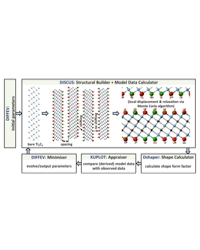
Schematic routine for multilevel modeling and refinement of neutron (and X-ray) total scattering data.
Scientific Achievement
A multilevel modeling and population-based refinement scheme (Figure 1) for neutron total scattering data was developed to capture the true nature of surface termination species present on Ti3C2Tx MXenes (T = surface species, including -OH, -O and -F). The experimentally-derived atomistic models (Figure 2) can replace the currently-used idealized models in predictions of a variety of physical, chemical and applied properties of Ti3C2-based MXenes.
Significance and Impact
A generalized methodology for modeling diffraction data was established to resolve the structures of layered electrode materials with real interfaces. The method can be adapted to study details of ion intercalation, electrode swelling, and other electrode surface-chemistry affects.
Research Details
- High-quality neutron total scattering measurements (at NOMAD beamline, SNS) for two kinds of Ti3C2Tx MXene show that the surface terminations control stacking.
- Modeling provides an unprecedented level of structural details (diverse surface functional groups and stacking disorder) for our material studies.


